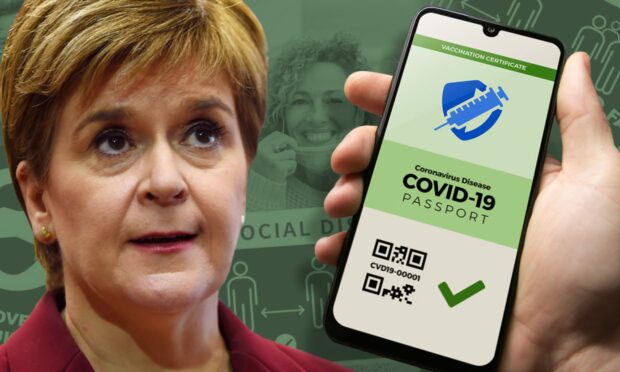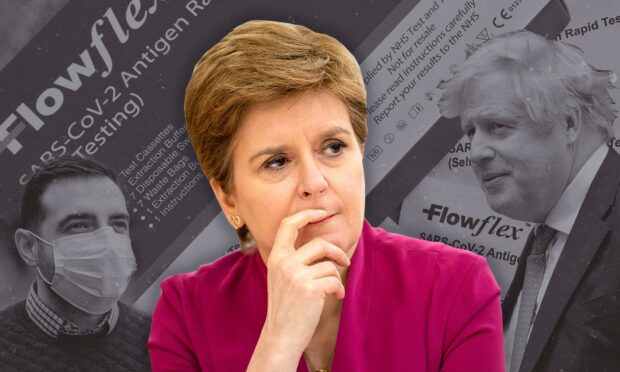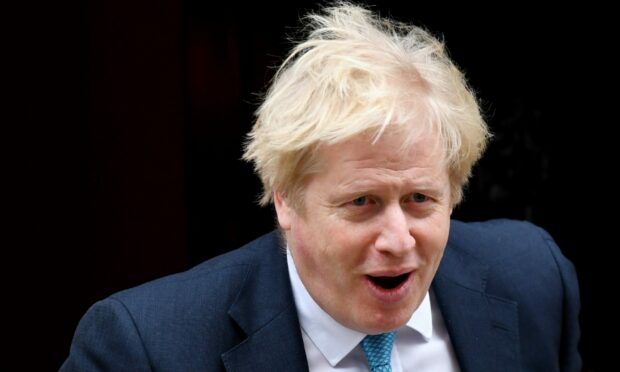Nicola Sturgeon outlined a plan for living with Covid-19, including the removal of mandatory face coverings and Covid passports, in a new route map out of the pandemic.
The legal requirement to wear face masks in public places is expected to be ditched from next month, and the Covid passport scheme will come to an end.
However, Ms Sturgeon is moving more cautiously than a plan outlined by Prime Minister Boris Johnson for England, and self-isolation for positive cases and testing will remain.
Here are five key things you need to know from the landmark announcement:
1. Face mask rules will be relaxed
The legal requirement to wear face masks in certain indoor settings and on public transport is expected to be dropped from March 21.
Instead, this will be converted into guidance.
The first minister said the government will continue to “strongly recommend” face covers are worn in shops, other indoor public places and on public transport.
This is an indicative date – assuming no significant adverse developments in the course of the virus – and will be confirmed at a future review.
The Scottish Government also expects to lift legal restrictions on businesses, places of worship and service providers on the same date.
The legal requirement on businesses and service providers to retain customer contact details is also expected to end on March 21.
2. Vaccine passports are being ditched
The Covid-19 certification scheme requiring venues such as nightclubs and sports stadiums to check the vaccine or test status of attendees will come to an end on February 28.
However, the app which supports the scheme will remain operational, meaning any business that wishes to continue the use of Covid passports can do so on a voluntary basis to reassure customers.

The scheme was introduced on October 1 in a bid to reduce the risk of transmission and keep higher risk settings open.
3. Self-isolation will remain in Scotland
Those who test positive for Covid-19 in Scotland – either through a PCR or a lateral flow test – will still be required to self-isolate for the recommended period.
This is in sharp contrast to the plan by Prime Minister Boris Johnson, who said people in England will no longer be required to self-isolate from February 24.
The first minister confirmed self-isolation support payments will remain available to those who are eligible.
Contact tracing and advice to contacts also continues at this point, as does support for those advised to isolate.
The recommended period of isolation will remain under review.
The SNP leader said: “It (isolating) helps limit transmission overall. And in helping keep workplaces and other settings safer, it also provides protection for those most at risk of serious illness from Covid, enabling them to return to more normal lives too.”
4. Free testing to continue despite cross-border row
The first minister outlined the government’s commitment to continued access to PCR and lateral flow testing free of charge during the transition phase.
The Scottish Government’s advice is those testing positive should continue to isolate but Ms Sturgeon said this will “transition to a system of testing that is more targeted”.
The only immediate change to testing is the frequency.
From February 28, the public will be encouraged to test at least twice a week and, in particular, if going to a crowded place or mixing with someone who is clinically vulnerable.
Ms Sturgeon criticised the decision by Mr Johnson to end universally free testing and said there was now a lack of clarity on funding for the testing programme for devolved countries.
Hitting out at the prime minister, the SNP leader said she must “express frustration at the position of the UK Government”.
She told MSPs: “It is, of course, for the Prime Minister to decide how best to tackle Covid in England.
“However, current funding arrangements mean that though taxpayers in all four UK nations contribute to the costs, it is decisions taken for England that determine the resources available to Scotland, Wales and Northern Ireland for testing and other Covid measures.”
The Scottish Government will publish a detailed plan for Test & Protect in March, when they hope they will have more clarity from the UK Government on available resources.
5. New threat level system in operation
The new update sets out a framework for any decisions the Scottish Government may have to take in the future in response to new developments.
The first minister said this is “intended as a contingency” and told MSPs she hopes “we never have to use it”.
This outlines three broad levels of future potential threat – low, medium and high.
Giving an example, Ms Sturgeon said: “If a new variant emerged that was more transmissible and more severe, perhaps with the ability to evade vaccine or natural immunity, this would likely be classified as high risk.
“In those circumstances, we might advise people to limit social contacts for a period; and to work from home where possible; and we may introduce some temporary protections for high risk settings.”
A new variant which was “either more transmissible or more severe but not both” – as is the case with Omicron – is likely to be rated a medium threat.
This could see the introduction of measures such as the legal requirement to wear face coverings in some settings.
Ms Sturgeon continued: “In the absence of a new variant, or if a new variant was neither more transmissible nor more severe – and if vaccines continue to be effective – the threat classification would likely remain low.
“Obviously, this is the level we hope to reach and stay at on a sustainable basis.
“In these circumstances, there would be no legally imposed protective measures. Instead, we would continue to advise individuals and organisations to adopt sensible public health behaviours.”

